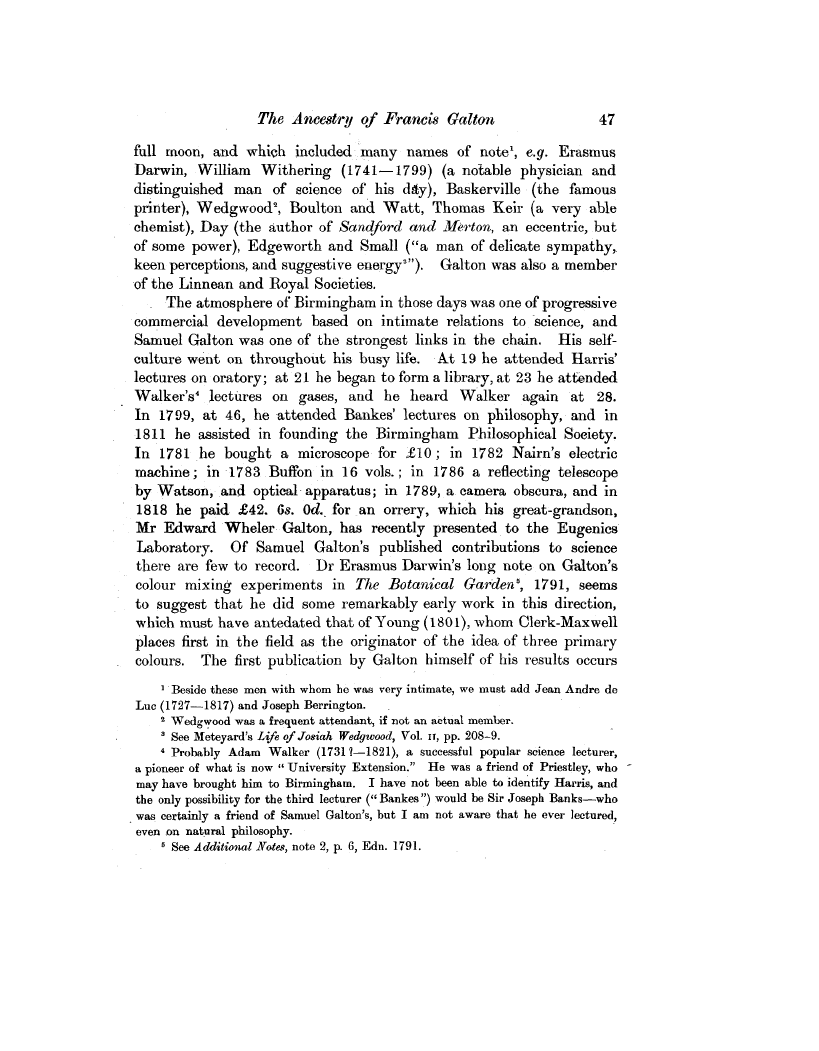| ||||||

OCR Rendition - approximate
The Ancestry of Francis Galton 47 full moon, and which included many names of note', e.g. Erasmus Darwin, William Withering (1741-1799) (a notable physician and distinguished man of science of his day), Baskerville (the famous printer), Wedgwood, Boulton and Watt, Thomas Keir (a very able chemist), Day (the author of Sandford and Merton, an eccentric, but of some power), Edgeworth and Small ("a man of delicate sympathy,. keen perceptions, and suggestive energy3"). Galton was also a member of the Linnean and Royal Societies. The atmosphere of Birmingham in those days was one of progressive commercial development based on intimate relations to -science, and Samuel Galton was one of the strongest links in the chain. His selfculture went on throughout his busy life. At 19 he attended Harris' lectures on oratory; at 21 he began to form a library, at 23 he attended Walker's' lectures on gases, and he heard Walker again at 28. In 1799, at 46, he attended Bankes' lectures on philosophy, and in 1811 he assisted in founding the Birmingham Philosophical Society. In 1781 he bought a microscope for £10 ; in 1782 Nairn's electric machine ; in 1783 Buffon in 16 vols. ; in 1786 a reflecting telescope by Watson, and optical- apparatus; in 1789, a camera obscura, and in 1818 he paid £42. Gs. Od.' for an orrery, which his great-grandson, Mr Edward Wheler Galton, has recently presented to the Eugenics Laboratory. Of Samuel Galton's published contributions to science there are few to record. Dr Erasmus Darwin's long note on Galton's colour mixing experiments in The Botanical Garden', 1791, seems to suggest that he did some remarkably early work in this direction, which must have antedated that of Young (1801), whom Clerk-Maxwell places first in the field as the originator of the idea of three primary colours. The first publication by Galton himself of his results occurs ' Beside these men with whom he was very intimate, we must add Jean Andre de Luc (1727-1817) and Joseph Berrington. 2 Wedgwood was a frequent attendant, if not an actual member. ' See Meteyard's Life of Josiah Wedgwood, Vol. is, pp. 208-9. ' Probably Adam Walker (1731?-1821), a successful popular science lecturer, a pioneer of what is now '° University Extension." He was a friend of Priestley, who may have brought him to Birmingham. I have not been able to identify Harris, and the only possibility for the third lecturer (°1 Bankes ") would be Sir Joseph Banks-who was certainly a friend of Samuel Galton's, but I am not aware that he ever lectured, even on natural philosophy. I See Additional Notes, note 2, p. 6, Edn. 1791.
|